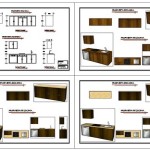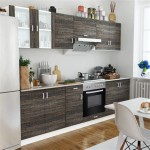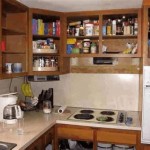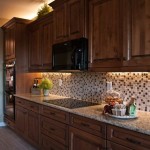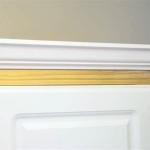The Best Way to Repaint Painted Kitchen Cabinets White
Repainting kitchen cabinets is a cost-effective method for updating the aesthetic of a kitchen without undertaking a full-scale renovation. Selecting white as the new cabinet color provides a clean, bright, and timeless look that can enhance the overall appeal of the space. However, achieving a professional, durable, and long-lasting finish requires meticulous preparation, careful execution, and the use of appropriate materials. This article details the comprehensive process for effectively repainting painted kitchen cabinets white, outlining essential steps and best practices.
Prior to commencing the repainting process, accurate assessment of the existing cabinet finish is crucial. Determine the type of paint currently on the cabinets (oil-based or latex), as this will influence the choice of primer and topcoat. A simple test can be performed by rubbing a small area of the existing paint with a cotton ball soaked in denatured alcohol. If the paint softens or comes off, it is likely latex-based. If the paint remains intact, it is likely oil-based. Furthermore, evaluate the condition of the cabinets for any damage, such as chips, dents, or peeling paint. Addressing these imperfections prior to painting is essential for a smooth and uniform final result.
Thorough Preparation: The Foundation for Success
Effective preparation is arguably the most critical phase of repainting kitchen cabinets. Skimping on preparation will invariably result in a substandard finish that is prone to chipping, peeling, and uneven color application. This phase includes removing hardware, cleaning the cabinets, sanding, and priming.
The first step is to completely remove all cabinet doors, drawers, and hardware, including knobs, pulls, hinges, and any decorative elements. Label each door and drawer with corresponding cabinet numbers to ensure proper reinstallation. Take photographs of the cabinet layout before disassembly to aid in remembering the placement of each component. Store the hardware in labeled bags to prevent loss or confusion. Place the cabinet doors and drawers on a clean, flat surface, such as a workbench or drop cloth-covered table.
Next, thoroughly clean all cabinet surfaces to remove grease, grime, dust, and any other contaminants. Use a degreasing cleaner specifically designed for kitchen surfaces. Trisodium phosphate (TSP) is a highly effective cleaning agent, but it requires careful handling and proper safety precautions, including wearing gloves and eye protection. Alternatively, a milder degreaser can be used, although multiple cleaning passes may be required. Rinse the cabinets thoroughly with clean water to remove any residue from the cleaning solution. Allow the cabinets to dry completely before proceeding to the next step.
Sanding is essential for creating a key for the new paint to adhere to. If the existing paint is glossy, sanding is particularly important to dull the surface and provide a mechanical bond. Use a medium-grit sandpaper (120-180 grit) for initial sanding, followed by a finer-grit sandpaper (220 grit) for smoothing the surface. Focus on sanding evenly across all surfaces, paying particular attention to edges, corners, and any areas with imperfections. Sanding sponges can be helpful for reaching tight spots and contoured surfaces. After sanding, use a tack cloth to remove all sanding dust. A vacuum cleaner with a brush attachment can also be used to thoroughly remove dust.
Priming is a critical step that ensures proper adhesion of the topcoat, blocks stains, and provides a uniform base for the white paint. Select a high-quality primer that is compatible with both the existing paint and the new topcoat. For oil-based paints, an oil-based primer is recommended. For latex-based paints, a latex-based primer or a bonding primer can be used. Apply the primer in thin, even coats using a brush, roller, or paint sprayer. Allow the primer to dry completely according to the manufacturer's instructions. Lightly sand the primed surface with fine-grit sandpaper (220 grit or higher) to remove any imperfections and create a smooth surface for the topcoat. Remove all sanding dust with a tack cloth.
Selecting the Right Paint and Application Techniques
Choosing the appropriate paint and employing correct application techniques are crucial for achieving a professional-looking and durable finish. Consider factors such as paint type, sheen, and application method.
For kitchen cabinets, alkyd (oil-based) or acrylic (water-based) paints are generally recommended. Alkyd paints offer excellent durability and a smooth, hard finish, but they require mineral spirits for cleanup and have a longer drying time. Acrylic paints are easier to clean up with water, have lower VOCs (volatile organic compounds), and are more flexible, making them less prone to cracking. However, they may not be as durable as alkyd paints. A hybrid paint, such as an alkyd-modified acrylic, can offer a good balance of durability and ease of use. Select a paint specifically formulated for cabinets and trim, as these paints are designed to withstand frequent cleaning and handling.
The sheen of the paint will affect the appearance and cleanability of the cabinets. A semi-gloss or gloss finish is generally recommended for kitchen cabinets, as these sheens are more durable and easier to clean. However, they also tend to highlight imperfections more than lower sheens. A satin or eggshell finish can be used for a more subtle look, but these sheens may be less durable and more difficult to clean. Consider the overall style of the kitchen and the desired aesthetic when selecting the paint sheen.
Paint can be applied using a brush, roller, or paint sprayer. Brushing is the most traditional method and is suitable for small projects or intricate details. Use a high-quality brush with synthetic bristles designed for the type of paint being used. Apply the paint in thin, even coats, using long, smooth strokes. Rollers are useful for covering large, flat surfaces quickly. Use a foam or microfiber roller with a short nap for a smooth finish. A paint sprayer provides the most professional-looking finish, as it applies the paint evenly and without brushstrokes or roller marks. However, using a paint sprayer requires practice and proper safety precautions, including wearing a respirator and eye protection. Regardless of the application method, apply the paint in thin, even coats, allowing each coat to dry completely before applying the next.
Apply at least two coats of paint for optimal coverage and durability. Lightly sand between coats with fine-grit sandpaper (220 grit or higher) to remove any imperfections and create a smooth surface for the next coat. Remove all sanding dust with a tack cloth before applying the next coat of paint.
Ensuring a Durable and Long-Lasting Finish
Beyond proper preparation and application, several additional steps can contribute to the longevity and durability of the newly painted kitchen cabinets.
Allow the paint to cure completely before reinstalling the hardware and using the cabinets. Curing is the process by which the paint hardens and reaches its full strength. The curing time can vary depending on the type of paint and the environmental conditions, but generally, it takes several days to a few weeks. Avoid cleaning the cabinets during the curing period. Once the paint is fully cured, reinstall the hardware and rehang the cabinet doors and drawers.
Consider applying a clear topcoat for added protection, especially if using a latex-based paint. A clear topcoat can enhance the durability of the paint and make it easier to clean. Select a clear topcoat that is compatible with the paint being used. Apply the topcoat in thin, even coats using a brush, roller, or paint sprayer. Allow the topcoat to dry completely according to the manufacturer's instructions.
Implementing careful cabinet maintenance practices will help preserve the integrity of the paint finish. Clean the cabinets regularly with a mild detergent and a soft cloth. Avoid using abrasive cleaners or scouring pads, as these can scratch the paint. Wipe up spills immediately to prevent staining. Periodically inspect the cabinets for any damage, such as chips or scratches. Touch up any damaged areas promptly to prevent further deterioration.
By adhering to these detailed steps and best practices, individuals can effectively repaint their painted kitchen cabinets white, resulting in a transformed kitchen space that is both aesthetically pleasing and functionally durable. The investment in time and effort during the preparation and application phases will yield significant dividends in the form of a professional-looking and long-lasting finish.

How To Prep And Paint Kitchen Cabinets Lowe S

How To Paint Kitchen Cabinets White In 5 Days For 150 The Nutritionist Reviews

The Best Way To Paint Kitchen Cabinets No Sanding Palette Muse

How To Re Paint Your Yucky White Cabinets

Ask Maria Help My White Painted Kitchen Cabinets Look Bad Advice For Homeowners

How To Re Paint Your Yucky White Cabinets

How To Paint Kitchen Cabinets White Let S Furniture

Painting Dark Kitchen Cabinets White My Weathered Home

How To Paint Oak Cabinets And Hide The Grain Tutorial

Painting Your Kitchen Cabinets White

